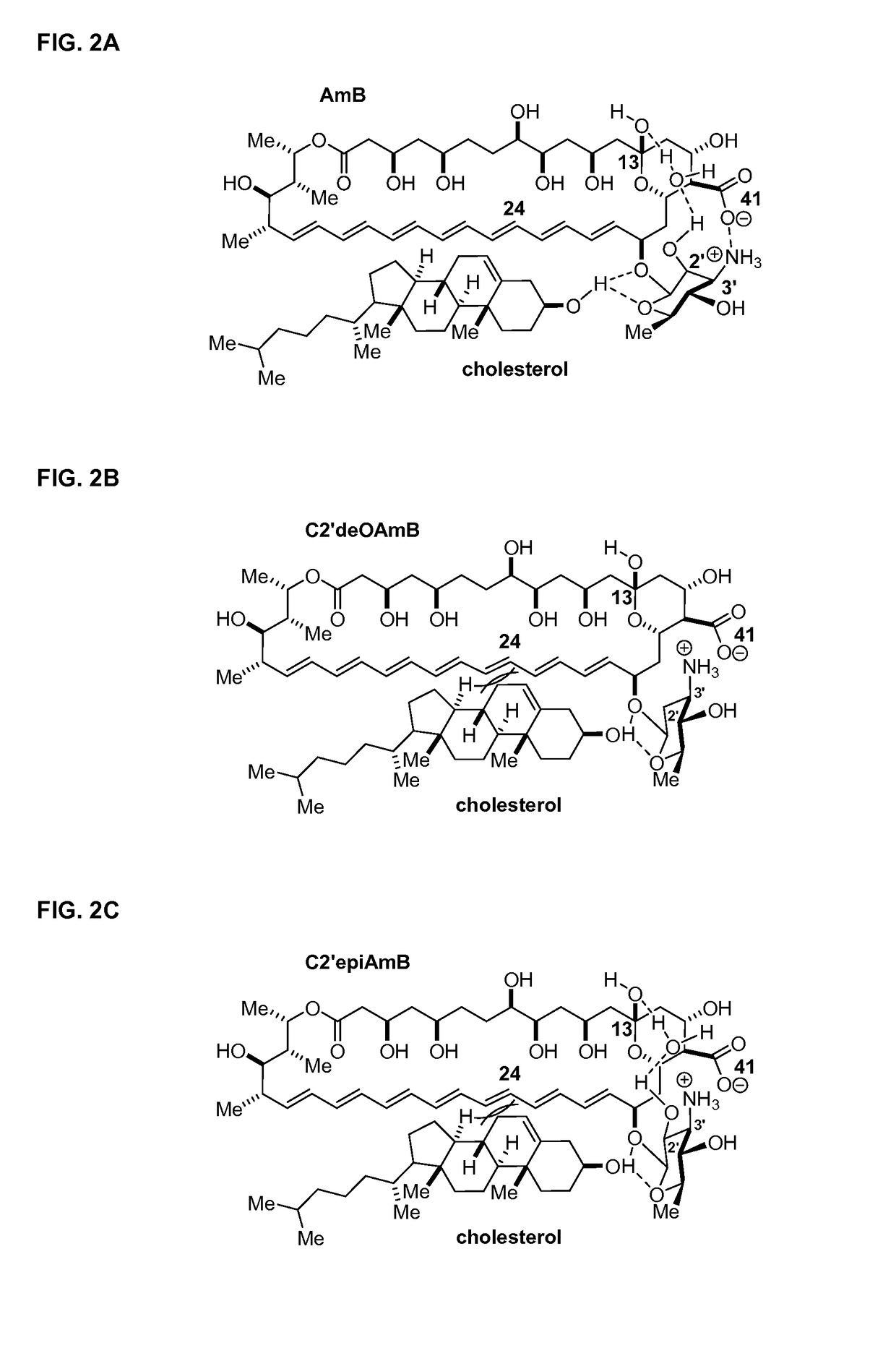Amphotericin B derivative with reduced toxicity
a technology of amphotericin and b derivative, which is applied in the field of amphotericin b derivative with reduced toxicity, can solve the problems of increasing the importance of amb improvement, limiting its effective utilization as the last line, and being toxi
- Summary
- Abstract
- Description
- Claims
- Application Information
AI Technical Summary
Benefits of technology
Problems solved by technology
Method used
Image
Examples
example 1
Synthesis of C2′epiAmB
[0120]In the first generation synthesis of C2′epiAmB, the Carreira synthesis of C2′epiAmE was modified to allow access to the deprotected material. Specifically, a readily removable allyl ester was employed at the C41-position. Employing a previously reported route to the fully protected aglycone 5.53b,5 with the mycosamine donor and glycosylation conditions previously used in the construction of C3′deNHAmB5, C2′epiAmB was synthesized (FIG. 3).
[0121]Although the synthesis of C2′epiAmB was possible from a hybrid glycosylation route similar to C2′deOAmB4 and C3′deNHAmB5, we realized that our previously reported site-selective acylation methodology of AmB could provide a more efficient and practical synthesis of C2′ epiAmB
[0122]In the second-generation synthesis of C2′epiAmB, depicted in FIG. 4, a different protecting group strategy was employed. Alloc was installed as the protecting group on the nitrogen. The C41 carboxylate was protected with an allyl group. Bot...
example 2
C2′epiAmB Binds Ergosterol but not Cholesterol
[0248]The binding capability of C2′epiAmB was investigated to determine whether epimerization at CT impacts the capacity of AmB to bind ergosterol. C2′epiAmB binds to ergosterol, but not cholesterol, within the limits of the binding assay, as indicated by FIG. 6.
[0249]ITC data for C2′epiAmB is as follows:
[0250]No sterol: Total exotherm=−6.70±0.11 μcal.
[0251]10% ergosterol: Total exotherm=−15.24±1.66 μcal.
[0252]10% cholesterol: Total exotherm=−6.43±2.80 μcal.
[0253]Exemplary methods of conducting the binding assay are described below.
[0254]Isothermal Titration calorimetry (ITC)
[0255]In an optimized isothermal titration calorimetry (ITC)-based assay, an aqueous solution of AmB was titrated with a suspension of large unilamellar vesicles (LUVs) comprised of only 1-palmitoyl-2-oleoyl-sn-glycero-3-phosphocholine (POPC), and the net exotherm was recorded. The titration was repeated using POPC LUVs containing 10% ergosterol. A significant increa...
example 3
C2′epiAmB Exerts Antifungal Activity In Vitro
[0269]The activity of AmB, C2′deOAmB, and C2′epiAmB against two ergosterol-containing strains of yeast, S. cerevisiae and C. albicans, was tested. C. albicans represents the most common cause of life-threatening systemic fungal infections in humans. As shown in FIG. 5, C2′epiAmB demonstrated potent antifungal activity against both S. cerevisiae (MIC=2 μM) and C. albicans (MIC=2 μM).
[0270]Exemplary methods for antifungal activity assays are as follows:
[0271]Growth Conditions for S. cerevisiae
[0272]S. cerevisiae was maintained with yeast peptone dextrose (YPD) growth media consisting of 10 g / L yeast extract, 20 g / L peptone, 20 g / L dextrose, and 20 g / L agar for solid media. The media was sterilized by autoclaving at 250° F. for 30 min. Dextrose was subsequently added as a sterile 40% w / v solution in water (dextrose solutions were filter sterilized). Solid media was prepared by pouring sterile media containing agar (20 g / L) onto Corning (Cor...
PUM
| Property | Measurement | Unit |
|---|---|---|
| pH | aaaaa | aaaaa |
| particle size | aaaaa | aaaaa |
| particle size | aaaaa | aaaaa |
Abstract
Description
Claims
Application Information
 Login to View More
Login to View More - R&D
- Intellectual Property
- Life Sciences
- Materials
- Tech Scout
- Unparalleled Data Quality
- Higher Quality Content
- 60% Fewer Hallucinations
Browse by: Latest US Patents, China's latest patents, Technical Efficacy Thesaurus, Application Domain, Technology Topic, Popular Technical Reports.
© 2025 PatSnap. All rights reserved.Legal|Privacy policy|Modern Slavery Act Transparency Statement|Sitemap|About US| Contact US: help@patsnap.com



